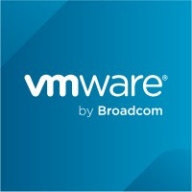

Google Compute Engine and VMware Cloud Foundation are leaders in the cloud infrastructure market, competing in flexibility and enterprise features. Google Compute Engine is favored for its flexibility and cost-effectiveness, making it preferable in areas of pricing and adaptability, while VMware Cloud Foundation excels in providing comprehensive features that offer better value for enterprise applications despite higher costs.
Features: Google Compute Engine integrates seamlessly with Google Cloud Platform services, allowing for customization of virtual machines, which includes operating ephemeral instances and managed instance groups that enhance cost efficiency and scalability. It simplifies processes with strong API integration and user-friendly deployment options. VMware Cloud Foundation simplifies data center management with automation, lifecycle management, and integration tools like the vSphere dashboard, excelling in handling private and hybrid cloud environments with a full-stack approach that reduces setup time.
Room for Improvement: Google Compute Engine can improve multi-region support, user interface aspects, and integration with non-Google systems, with licensing BYOL being particularly cumbersome and needing better SQL query support. VMware Cloud Foundation faces challenges with complex upgrade processes, integration with other VMware products, and high costs, with the need for better documentation, lifecycle management, and enhanced security features.
Ease of Deployment and Customer Service: Google Compute Engine is known for its ease of deployment in public cloud settings, while VMware Cloud Foundation offers broader deployment options, including on-premises and hybrid clouds. Google’s customer support has mixed reviews, with prompt responses but limited resolution. VMware provides comprehensive support that particularly benefits larger enterprises with robust private cloud capabilities.
Pricing and ROI: Google Compute Engine offers competitive pay-as-you-go pricing with ROI that includes cost savings of up to 90% for development and testing, though it may be expensive compared to AWS. VMware Cloud Foundation is expensive but provides cost savings through bundled licensing and feature-rich offerings. Both solutions display varied ROI, with Google Compute Engine suited for agile development and VMware delivering value through operational efficiency for complex enterprise environments.
VMware Cloud Foundation allows cost and time savings by quickly deploying infrastructure requests and integrating automatic ticketing and backup services.
In terms of ROI, although VMware Cloud Foundation is expensive, it saves time in most cases, which indirectly saves costs for users.
There are times when support is unclear, and even VMware support personnel may lack familiarity with certain parts, causing difficulties.
Based on my nine years of experience with VMware, I would evaluate their technical support as effective.
Support was reliable and responsive before the acquisition by Broadcom.
VMware Cloud Foundation supports scalability and company growth.
When more hosts are added, performance goes slow.
VMware Cloud Foundation is quite scalable, receiving a rating of eight and a half to nine out of ten.
If one component fails to operate in a timely manner, the entire infrastructure can go down because everything is interconnected.
The stability of VMware Cloud Foundation is very high.
I am currently satisfied with the stability of VMware Cloud Foundation, though having started only two to three months ago, I am still in the monitoring phase.
VMware Cloud Foundation is complex, and there are always updates regarding security features, accessibility, and the user interface.
Each user needs deep knowledge of every aspect of virtualization.
The maintenance cost has increased significantly, especially after Broadcom acquired VMware, with a shift from socket-based licensing to core-based licensing.
The cost has become very high, especially after Broadcom's acquisition, altering the licensing model to a more expensive core-based system.
The price is quite higher than some other vendors.
VMware Cloud Foundation is quite expensive when compared to its competitors, but it does save time, which in turn saves money.
In GCP, there's a custom configuration feature unlike AWS and Azure.
With VMware Cloud Foundation, auto-deployment is possible by simply right-clicking and assigning a specific DHCP IP, enabling physical to vCenter level communication for automatic VM deployment.
All features of VMware Cloud Foundation are valuable to us, as it covers every industry standard protocol and requirement protocol.
VMware Cloud Foundation allows for extensive customization, aligning with our customer requirements.
| Product | Market Share (%) |
|---|---|
| VMware Cloud Foundation | 1.4% |
| Google Compute Engine | 1.0% |
| Other | 97.6% |


| Company Size | Count |
|---|---|
| Small Business | 5 |
| Midsize Enterprise | 4 |
| Large Enterprise | 7 |
| Company Size | Count |
|---|---|
| Small Business | 7 |
| Midsize Enterprise | 3 |
| Large Enterprise | 27 |
Google Compute Engine delivers virtual machines running in Google's innovative data centers and worldwide fiber network. Compute Engine's tooling and workflow support enable scaling from single instances to global, load-balanced cloud computing.
Compute Engine's VMs boot quickly, come with persistent disk storage, and deliver consistent performance. Our virtual servers are available in many configurations including predefined sizes or the option to create Custom Machine Types optimized for your specific needs. Flexible pricing and automatic sustained use discounts make Compute Engine the leader in price/performance.
VMware Cloud Foundation makes it easy to deploy and run a hybrid cloud. VMware Cloud Foundation provides integrated cloud infrastructure (compute, storage, networking, and security) and cloud management services to run enterprise applications in both private and public environments.
We monitor all Infrastructure as a Service Clouds (IaaS) reviews to prevent fraudulent reviews and keep review quality high. We do not post reviews by company employees or direct competitors. We validate each review for authenticity via cross-reference with LinkedIn, and personal follow-up with the reviewer when necessary.